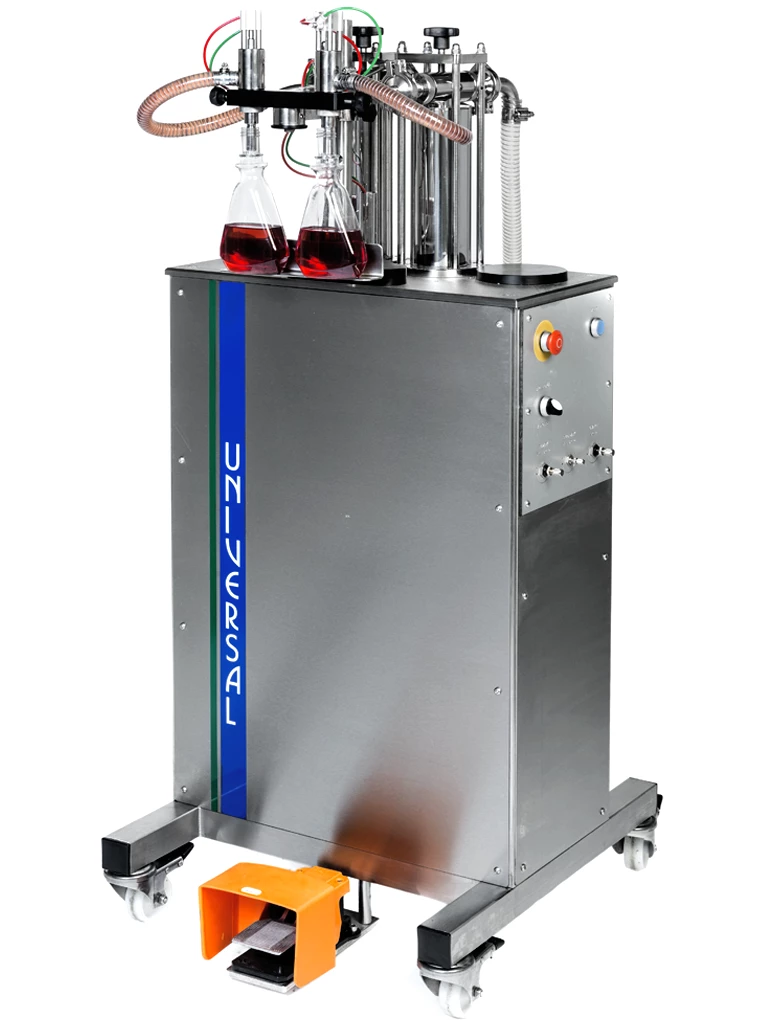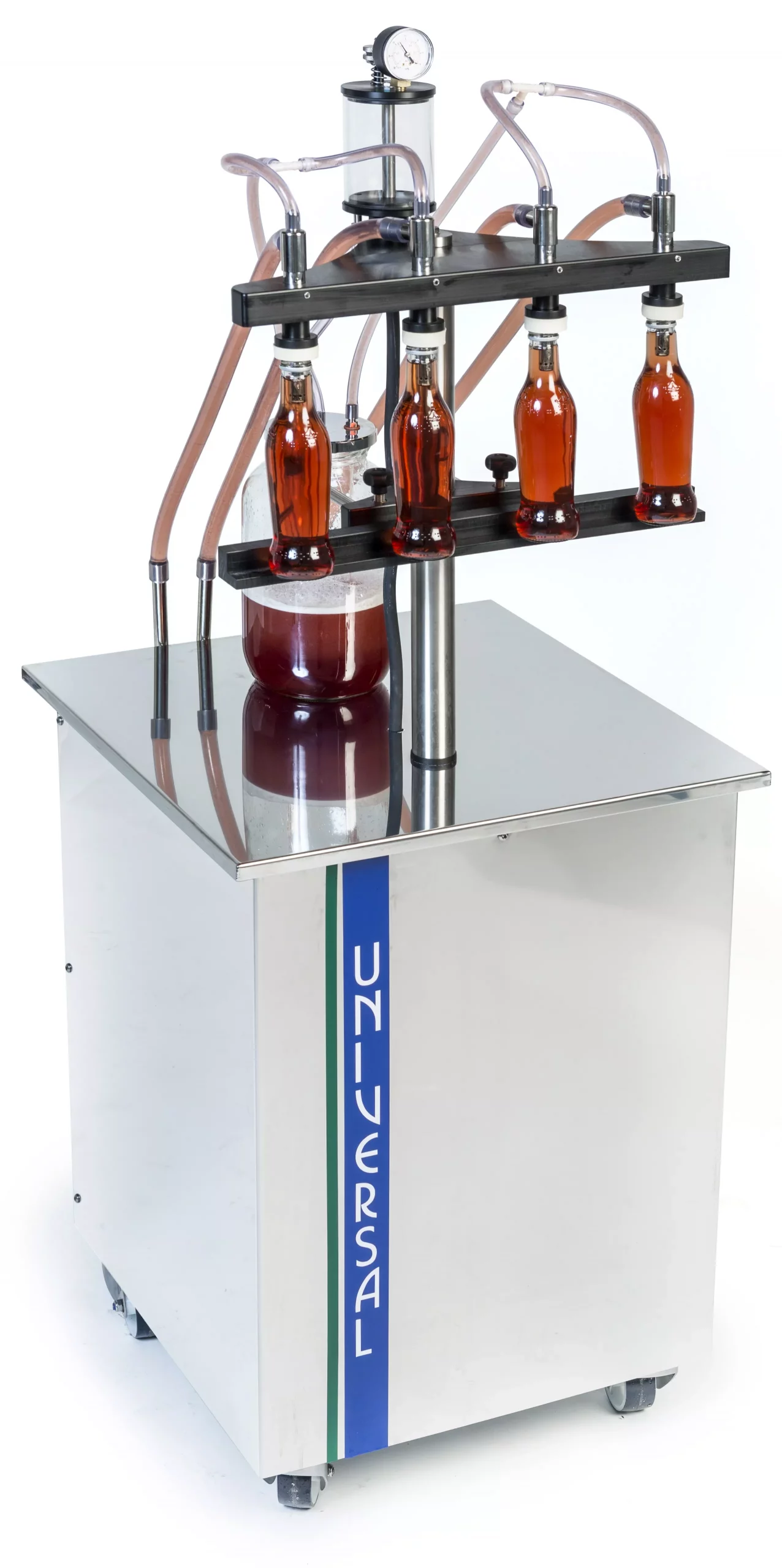Two distinct filling technologies are available for semi-automatic and fully automatic filling machines: volumetric and vacuum-level filling.
Manually operated filling machines tend only to fill volumetrically.
Volumetric filling machines
Manual liquid filling machines use a piston within a cylinder to force liquid into the container.
These normally have a pneumatically powered pump mechanism, set to fill containers with the required volume of liquid, fed from either a floor-standing container or a machine-mounted hopper.
Containers are positioned below the filling nozzles and a foot pedal switch to start the filling process.
Volumes between 5ml and 25-litres can be handled by volumetric filling machines and up to 150 containers per minute can be filled, depending on the fill volume, liquid viscosity and level of machine automation.

Vacuum level filling machines
Vacuum level semi-automatic filling machines use the rim at the top of the container to form an airtight seal around the filling nozzle.
This airtight seal creates a vacuum within the bottle which draws free-flowing liquids from a supply tank into the bottle, via specially designed nozzles. These nozzles have a small hole on the side which is connected to a small internal tube.
The height of this hole in relation to the top of the container during filling determines the level of liquid dispensed. The small hole in the nozzle scavenges excess liquid from the filling process and collects it in a receiver for reuse.
Vacuum level filling machines fill containers to the same height each time, rather than dispensing the same volume. This is particularly useful for glass bottles which will be side-by-side on display shelves in shops. Glass bottles vary in capacity quite a lot, yet vacuum-level filling ensures the level each bottle is filled to is the same, giving a consistent appearance from one bottle to the next. Vacuum level filling requires rigid containers which won’t collapse under a vacuum.

Vacuum-level machines have virtually no moving parts, making them incredibly reliable, and can fill up to 120 bottles per minute depending on the container type, number of filling heads and level of automation.
Bottles are simply positioned with their top in contact with a sealing ring around the nozzle. The container will start to fill as soon as an airtight seal is made and stop when the pre-determined fill height is reached.
Two distinct filling technologies are available for semi-automatic and fully automatic filling machines: volumetric and vacuum-level filling.
Manually operated filling machines tend only to fill volumetrically.
Volumetric filling machines
Manual liquid filling machines use a piston within a cylinder to force liquid into the container.
These normally have a pneumatically powered pump mechanism, set to fill containers with the required volume of liquid, fed from either a floor-standing container or a machine-mounted hopper.
Containers are positioned below the filling nozzles and a foot pedal switch to start the filling process.
Volumes between 5ml and 25-litres can be handled by volumetric filling machines and up to 150 containers per minute can be filled, depending on the fill volume, liquid viscosity and level of machine automation.

Vacuum level filling machines
Vacuum level semi-automatic filling machines use the rim at the top of the container to form an airtight seal around the filling nozzle.

This airtight seal creates a vacuum within the bottle which draws free-flowing liquids from a supply tank into the bottle, via specially designed nozzles. These nozzles have a small hole on the side which is connected to a small internal tube.
The height of this hole in relation to the top of the container during filling determines the level of liquid dispensed. The small hole in the nozzle scavenges excess liquid from the filling process and collects it in a receiver for reuse.
Vacuum level filling machines fill containers to the same height each time, rather than dispensing the same volume. This is particularly useful for glass bottles which will be side-by-side on display shelves in shops. Glass bottles vary in capacity quite a lot, yet vacuum-level filling ensures the level each bottle is filled to is the same, giving a consistent appearance from one bottle to the next. Vacuum level filling requires rigid containers which won’t collapse under a vacuum.
Vacuum-level machines have virtually no moving parts, making them incredibly reliable, and can fill up to 120 bottles per minute depending on the container type, number of filling heads and level of automation.
Bottles are simply positioned with their top in contact with a sealing ring around the nozzle. The container will start to fill as soon as an airtight seal is made and stop when the pre-determined fill height is reached.
Two distinct filling technologies are available for semi-automatic and fully automatic filling machines: volumetric filling and vacuum-level filling. Manually operated filling machines tend only to fill volumetrically.
Volumetric filling machines
Manual liquid filling machines use a piston within a cylinder to force liquid into the container.
These normally have a pneumatically powered pump mechanism, set to fill containers with the required volume of liquid, fed from either a floor-standing container or a machine-mounted hopper.
Containers are positioned below the filling nozzles and a foot pedal switch to start the filling process.
Volumes between 5ml and 25-litres can be handled by volumetric filling machines and up to 150 containers per minute can be filled, depending on the fill volume, liquid viscosity and level of machine automation.

The PB5000 volumetric filling machine is designed to handle acids, alkalines and bleaches. As a result, the contact parts are made from glass & PVC because even 316 stainless steel cannot withstand such liquids.
The transparent metering cylinders fitted to the PB5000 enable you to see the liquid being displaced by the movement of the piston and actuator assembly. As the piston rises, liquid is forced through the metering valve, to the filling nozzles.
When filling is complete, the metering valve switches over, to only allow liquid to enter the metering from the intake hoses. Momentarily later, the actuator starts to draw the piston back, drawing fresh liquid in to the metering cylinders for the next cycle.
This particular model of liquid filling machine is a 2-head volumetric filler, which means it fills 2 containers at the same time. As the video shows, a single pneumatic actuator controls both pistons, to ensure fill volume consistency.
We make a wide range of volumetric filling machines, click on a link below to learn more about a specific machine, or visit our Liquid Filling Machines page.

Vacuum level filling machines
Vacuum level semi-automatic filling machines use the rim at the top of the container to form an airtight seal around the filling nozzle.
This airtight seal creates a vacuum within the bottle which draws free-flowing liquids from a supply tank into the bottle, via specially designed nozzles. These nozzles have a small hole on the side which is connected to a small internal tube.
The height of this hole in relation to the top of the container during filling determines the level of liquid dispensed. The small hole in the nozzle scavenges excess liquid from the filling process and collects it in a receiver for reuse.
Vacuum level filling machines fill containers to the same height each time, rather than dispensing the same volume. This is particularly useful for glass bottles which will be side-by-side on display shelves in shops. Glass bottles vary in capacity quite a lot, yet vacuum-level filling ensures the level each bottle is filled to is the same, giving a consistent appearance from one bottle to the next. Vacuum level filling requires rigid containers which won’t collapse under a vacuum.
Vacuum-level machines have virtually no moving parts, making them incredibly reliable, and can fill up to 120 bottles per minute depending on the container type, number of filling heads and level of automation.
Bottles are simply positioned with their top in contact with a sealing ring around the nozzle. The container will start to fill as soon as an airtight seal is made and stop when the pre-determined fill height is reached.
Universal’s vacuum filling machines use special filling nozzles which have a secondary, small-diameter tube within their main tube, that exits through the side of the main nozzle tube, near its tip. The other end of this small tube is connected to the vacuum side of the machine via an excess liquid capture jar, and constantly draws a vacuum all the time the machine is switched on.
When a bottle is positioned on to the nozzle and an airtight seal is created with the nozzle sealing rubbers, this vacuum creates lower-than-atmospheric pressure within the bottle.
The larger diameter tube which forms the main body of the filling nozzle is connected to the liquid supply via hoses.
The reduced pressure within the bottle forces the liquid to be drawn along its supply hose, through the main body of the nozzle and in to the bottle. The vacuum continues to draw liquid in to the bottle until it reaches the height of the smaller vacuum tube in the side of the main nozzle’s body. At this point, the smaller ‘Suck Back Tube’ within the nozzle starts to draw excess liquid, rather than air, and diverts any excess to the excess liquid capture jar at a greatly reduced speed, due to the small diameter of the Suck Back Tube.
The Excess Liquid Capture Jar is also airtight and forms part of the vacuum system. Periodically, the machine can be switched off and the contents of the jar can be returned to the liquid supply vessel for re-use.
The machine shown in this video has an additional upgrade which automatically returns excess liquid to the supply vessel via a float and valve arrangement.
We make a range of vacuum filling machines to suit all scales of production; from the Vacufill benchtop 1 or 2 filling head machines, to the Posivac fully automatic filling machine which can be specified with up to 12 filling heads. Click on a link below to learn more about a specific machine, or visit our Liquid Filling Machines page.